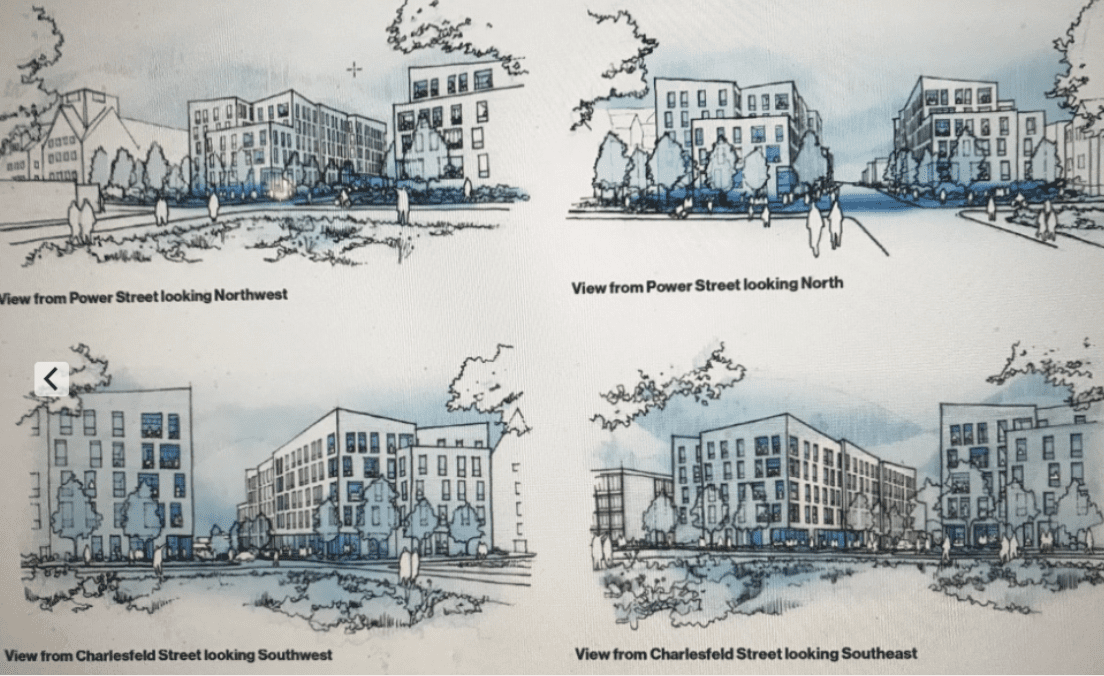Search Posts
Recent Posts
- Outdoors in RI: Help keep recreation areas clean. Invasive Milfoil, trash. 2A update – Jeff Gross July 26, 2024
- Real Estate in RI: Highest-ever sale in Queen’s Grant, EG $1.25M, by Residential Properties July 26, 2024
- Homeless in RI: Gov. Newsom issues Executive Order. Remove California’s encampments. July 26, 2024
- Let the games begin. XXXIII Summer Olympics – John Cardullo July 26, 2024
- GriefSPEAK: What would you do? – Mari Dias Nardolillo July 26, 2024
Categories
Subscribe!
Thanks for subscribing! Please check your email for further instructions.

Another travesty at Brown? – David Brussat
by David Brussat, Architecture Here and There, contributing writer
Brown sent a gang of its minions to present its latest proposed abomination to the Fox Point Neighborhood Association last night. The two huge rectangular boxes with skewed roofs on either side of poor Brook Street (disembowled recently by the nearly completed student wellness center several blocks to the north) would create a forbidding allee along the street that parallels Thayer a block farther east.
The Brown officials, reinforced by a team from Deborah Berke Partners, the architect, were received politely by the FPNA. Yet it was clear that the group’s leaders and members were very distressed by the proposal, which would remove four buildings, three of them attractive old houses, from the historic residential district that once dominated the area.
It is doubly fortunate that the neighbors as well as the FPNA folks, interacting by Zoom, were largely in agreement that, among other issues, the two buildings’ poor fit with College Hill/Fox Point’s historical fabric was the key issue. A host of opponents stated or read effective remarks refuting (not just rebutting) the Brown officials’ presentation. Brown responded to all the minor objections in an obvious effort to ignore the elephant in the room. Nevertheless, said architect Noah Biklen, Brown ’97, “We are working within a modern idiom.” Yes, and that’s the big problem. The statement by Arria Bilodeau was remarkably blunt on this point, focusing on the design issue. Below is the text of her remarks:
***
Statement on Brown’s Proposed Dorms
By Arria Bilodeau
Brown’s proposed plans for two new dorms have been modified in response to the Historic District Commission negative reception, and, purportedly, to concerns voiced by neighbors.
From the neighbors’ point of view, our objections have as yet been unaddressed.
West dorm
The intrusion of the west dorm into the local historic district has been removed, and an open space, planned to be landscaped and green, has replaced the retail component on the south-west [portion of the] dorm.
However, the dorm building designed by Deborah Berk Partners continues to incorporate design elements that have been almost universally rejected by the surrounding community:
- the irrelevant and jarring roofline (not characteristic of the abutting built environment);
- extended, elongated windows (not reflective of the surrounding styles);
- a seemingly non-conforming brick siding (not “Brown brick found everywhere else on campus, and immediately next door in the Vartan Gregorian quadrangle facing the west dorm from the east);
- and an industrial, urban office-building shape (not respectful of scale, density or character of the adjacent buildings).
The design of the dorm has not fundamentally changed. It is a replication of the architect’s similar buildings on two other campuses, and does not offer a signature design statement of any distinction for Brown.
Erecting two of them, facing each other in one block next to our homes, is a dismal prospect.
East dorm
In the 1980s, Brown cleared the northeast corner for a future dorm by demolishing two houses. Across Charlesfield Street, however, Brown handsomely restored a Victorian house – of 3½ stories, which is one of a whole block of houses on Brook, running north from Charlesfield. In other words, the context on this side of Brook is residential housing stock, as was the building at the western corner of Brook and Charlesfield.
Again, a five-story, vertically oriented, erratic-roofed massive dormitory with elongated windows singularly fails to make any gesture at fitting into the neighborhood, where the Institutional Zone abuts the surrounding housing stock. The architects have not acknowledged that this is a residential setting. Their dorms will be bordering a residential neighborhood of family-occupied homes and yards.
Corner of Brook and Power
There has been no neighborhood clamor for “open space” or “green space” at the Power and Brook intersection. The northeast corner lot is, in fact, missing a tooth. And Brown owns the missing tooth: the multi-family house on Brook it says it must demolish. Whatever effort must be made to convince the City to allow the lot to be used for a house – and put on the tax rolls – is definitely not beyond Brown’s power, and is within the City planning goal of increasing density.
Additionally, the pink house at 126 Power should be added to the Brown-to-Brown program, sold to an owner-occupant, and kept on the tax rolls as well. This would be in keeping with the character of the neighborhood.
In sum
Brown has latitude within the Institutional Zone to expand and increase density in its development. However, the Comprehensive Plan speaks to institutional growth in three Objectives that should be taken into account in this dorm proposal. These are the words of Brown’s Comprehensive Plan:
- Objective LU7: Allow for institutional growth while preserving neighborhoods. Require institutions to use their land … and expand … while ensuring compatibility with the surrounding neighborhood.
- Objective BE5: Preservation Planning. Preserve the historic buildings, districts and areas that contribute positively to Providence’s urban fabric.
- Objective BE7: Neighborhood Character and Design. Encourage developments to be compatible with surrounding uses in scale, density and character, while not stifling innovative design and architecture.
Brown has yet to provide a building of sufficient architectural merit and sensitivity to its immediate surroundings to serve as its interface with the City’s and our historic neighborhood.
***
These remarks by Ms. Bilodeau are about as tart a response as I can recall to Brown’s half a century of insensitive expansion of its campus on College Hill. Since 1960 or thereabouts, Brown has gone stark, raving modernist, blasting huge holes in the historic fabric of its host city. The only exceptions have been, in 1990, the addition on George Street to the John Carter Brown Library (which is not even a part of the university), and the 2012 Jonathan Nelson Fitness Center on Hope Street, from which Brown learned nothing. Brown has been very good at restoring old buildings, occasionally relocating them to make way always for inexplicable carbuncles, but that has probably caused decades of Brown facilities officials to grind their teeth to a fare-thee-well.
About a year ago I wrote a post, “At Brown, here we go again,” in which I beat Brown, Deborah Berke Partners and its ex-Brown architect Noah Biklen severely about the head and shoulders for voicing flagrant untruths about their declared goal of integrating new buildings, including these dorms, into neighborhoods. Drawings were not even available at the time, but now that we have the designs, they are quite as bad as I predicted, even after the recent, irrelevant changes cited by Arria Bilodeau.
She, the neighborhood and its leaders at the Fox Point Neighborhood Association have been much more direct and forceful in their objections to the design of the proposed dormitories. At last night’s meeting, Brown and its architects expressed a willingness to revise its proposals with advice from the neighbors in mind. The neighbors should be inspired by the success, just a month ago, of neighbor opposition to a developer’s proposal for an addition to a dear old cottage on Williams Street. After offering designs that got more and more modernist over time, the architect, Friedrich St. Florian, did a 180 and offered a proposed addition that was quite in keeping with the historic character of the neighborhood. I wish I’d been a fly on the wall when the Historic District Commission issued its ultimatum (I presume) to the developer!
It is clear that Brown could build dormitories quite as large as it needs with proper massing and historic detailing inspired by the campus buildings most beloved by Brown itself and the community. The neighbors would love it. The longstanding town vs. gown headaches caused by decades of insensitive Brown development on College Hill would largely evaporate, Brown’s genuine reputation as a city benefactor would shine more luxuriantly as its role as “local villain” disappeared, and the university would reap greater alumni donations in the future if new parts of the campus were more lovable. Let’s hope Brown and its architects were really listening last night.
_____

My freelance writing and editing on architecture and others addresses issues of design and culture locally and globally. I am a member of the board of the New England chapter of the Institute of Classical Architecture & Art, which bestowed an Arthur Ross Award on me in 2002. I work from Providence, R.I., where I live with my wife Victoria, my son Billy and our cat Gato. If you would like to employ my writing and editing to improve your work, please email me at my consultancy, [email protected], or call (401) 351-0457 https://architecturehereandthere.com/

Great article which shows the local’s view of this intrusion of an old and historic neighborhood by non tax payers . Keep up the good work .